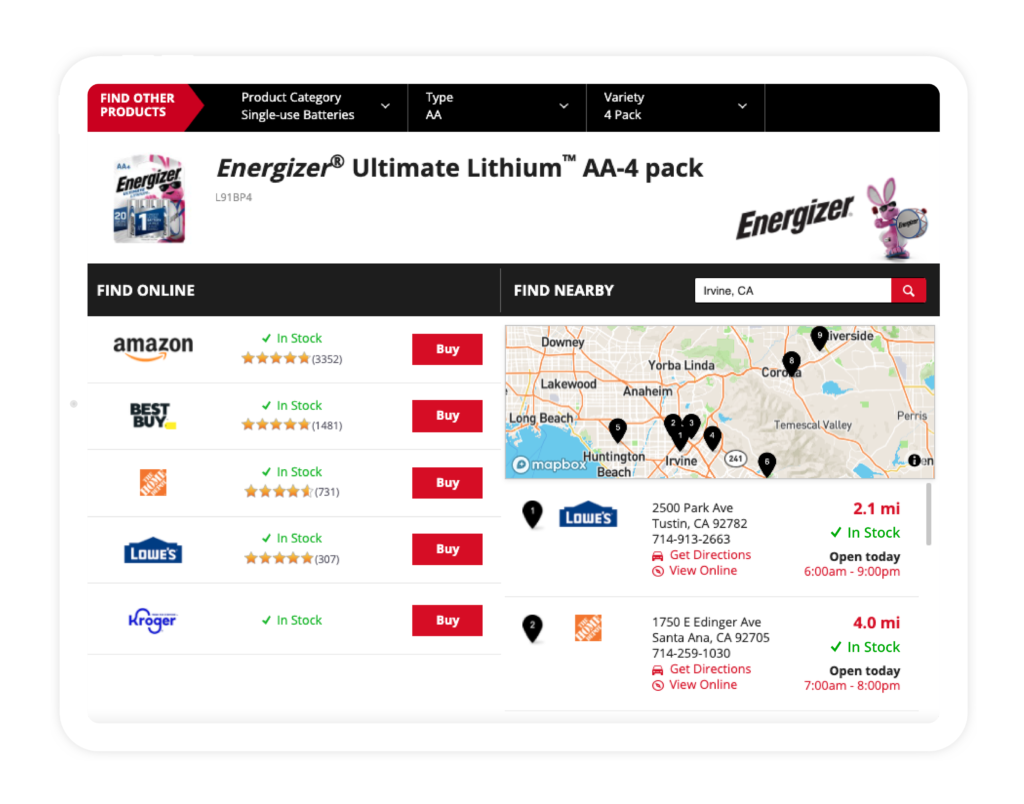“Shut up and take my money!” is the highly meme-able refrain every brand strives for. Stop putting obstacles between me and your unbelievable product. Of course we all would love to oblige. It turns out taking an enthusiastic customer’s money is sometimes easier said than done. Step one: make your content shoppable.

Shoppable media is digital content that empowers consumers to shop. While brands often link ads, posts, videos, and other digital assets directly to their product pages, shoppable media introduces choice, presenting consumers with the information they need to compare buying options and clear pathways to each store.

While the term might bring to mind a native checkout experience like Checkout on Instagram, enabling purchases isn’t what makes media shoppable. It’s “shoppable” because your viewers can compare pricing, stock availability, buying options, and more directly from your media — whatever that media may be.
When brands force consumers into a single distribution channel (such as their own direct-to-consumer store), it skips a crucial stage on the customer journey: comparison. If you don’t give consumers the information they need to shop, they’re going to look elsewhere — where your competitors have a chance to intercept them and their preferences may lead them to a dead end.
Shoppable media helps brands overcome these challenges.
Control the path to purchase
Most consumers won’t buy from just anywhere. They have stores they prefer to buy from. Amazon. Walmart. Target. Best Buy. Home Depot. When consumers see a product they want, they default to the stores they’re most familiar and comfortable with.
If you only give people one buying option, it creates friction with their preferred path to purchase and forces them to take additional steps. Instead of getting where they want to go with a click, they have to leave your website, go to Google or a retailer’s search engine, and then find and select your product page.
That might not seem like much, but the harder it is to buy from you, the less you’re going to sell.
So, what if someone’s preferred store doesn’t carry your products? They’ll be a lot more willing to choose a different store if you can show them viable alternatives. Even if someone strongly prefers Amazon, they know what kind of buying experience they can expect from a reputable retailer like Kroger or Target. In fact, they probably shop there, too.
Shoppable media gives you the power to say, “These are all great options.” Then your customers can decide on the best choice available, even if it’s not their all-time favorite store.
Since your customers don’t have to wander the web looking for other online stores that carry your products, you stay in control of the path to purchase. And that prevents you from running into additional problems, like dead ends.
Eliminate dead ends
Any time a potential customer leaves your website and can’t find your product available at their preferred stores, that’s a dead end. You don’t want someone who is ready to buy on your website leaving to check Walmart.com. If your products aren’t there, your visitor may start thinking about what is available at Walmart (and of course, Walmart will attempt to show them the best substitute). Or they’ll give up.
The same is true when a store carries your product but happens to be out of stock. It’s a dead end. They can’t buy your product there right now.
This is where it becomes especially important for brands to use shoppable media that displays current stock information — not information from last week, yesterday, or a few hours ago. The last thing you want is for a customer to find a local store, take your word for it that the product is available, then make a trip to the store only to learn that it’s out of stock. Even if they’re just trying to buy online, sending them to a website that’s out of stock teaches your visitors that they can’t trust you to give them accurate information, and that’s where their “path to purchase” will end before they buy.
Shoppable media that includes accurate information about various buying options lets people select a path they’re comfortable with. And if their top store preference isn’t on the list, they’re much more likely to assume it’s not an option and make a different choice.
Reduce competition
When people don’t see a path to purchase that they’re comfortable with, they Google your product name or look for it through a retailer’s search engine. Each path could expose them to competitors. Other brands use display ads for your product name and category, and both Google and major retailers give searchers multiple options, which means their search results will be populated with more than just your product.
You want your customers to think, “Where should I buy this product?” Not “Which product should I buy?”
Controlling the path to purchase removes some of your competitors’ biggest opportunities to siphon your sales.
So, how do you actually make your media shoppable?
How does shoppable media work?
Shoppable media depends on two things:
- Clear pathways to a variety of distribution channels
- Current data
Your audience needs a convenient way to compare options, make informed decisions, and select a store.
You could manually type out all the information and links people need, but even if that doesn’t create logistical challenges and formatting issues, the information could quickly become outdated, and then it’s no longer useful.
You could build a custom solution that dynamically updates with information from your sellers. But that’s a huge upfront investment, and you’ll likely wind up with a pretty limited tool.
Most brands rely on third-party software solutions, like PriceSpider’s Where to Buy. Where to Buy displays real-time data pulled right from your sellers’ product pages with a simple, intuitive application. When customers click your ads and other content, this specialized software lets them select their path to purchase.
You decide what information your widget displays and which stores customers see; you can prioritize your best-performing partners or the ones people are most familiar with.
Where to Buy uses our proprietary “spidering” technology to browse product pages just like a consumer would. It always displays current product data, and when pricing or availability changes, it knows. Remember, if you can’t provide your audience with reliable, up-to-date information, they won’t trust you to help them shop.
When you decide to make your media shoppable, make sure to give your customers data they can actually use to make their buying decisions.
Start creating shoppable media
PriceSpider has been perfecting store locator technology for almost 20 years and has continued to innovate to evolve this technology to make brands shoppable. Nearly 2,000 brands rely on our tools to maximize their conversions, control the path to purchase, and gain visibility into the buyer journey.
If you’d like to make it simpler for your customers’ to happily give you their money for your products by connecting them to reliable, in-stock retailers, Where to Buy is your best bet to maximize your brand’s shoppability.
Schedule a demo to see Where to Buy in action.

